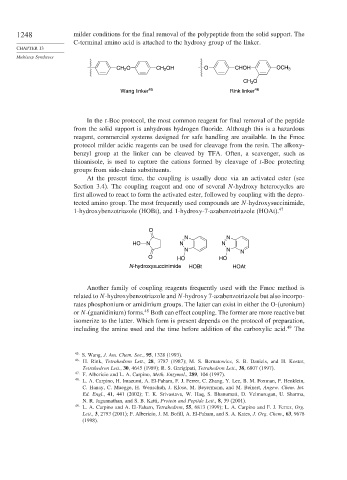Page 1272 - Advanced Organic Chemistry Part B - Reactions & Synthesis
P. 1272
1248 milder conditions for the final removal of the polypeptide from the solid support. The
C-terminal amino acid is attached to the hydroxy group of the linker.
CHAPTER 13
Multistep Syntheses
CH 2 O CH 2 OH O CHOH OCH 3
CH 3 O
Wang linker 45 Rink linker 46
In the t-Boc protocol, the most common reagent for final removal of the peptide
from the solid support is anhydrous hydrogen fluoride. Although this is a hazardous
reagent, commercial systems designed for safe handling are available. In the Fmoc
protocol milder acidic reagents can be used for cleavage from the resin. The alkoxy-
benzyl group at the linker can be cleaved by TFA. Often, a scavenger, such as
thioanisole, is used to capture the cations formed by cleavage of t-Boc protecting
groups from side-chain substituents.
At the present time, the coupling is usually done via an activated ester (see
Section 3.4). The coupling reagent and one of several N-hydroxy heterocycles are
first allowed to react to form the activated ester, followed by coupling with the depro-
tected amino group. The most frequently used compounds are N-hydroxysuccinimide,
1-hydroxybenzotriazole (HOBt), and 1-hydroxy-7-azabenzotriazole (HOAt). 47
O
N N
HO N N N
N N N
O HO HO
N-hydroxysuccinimide HOBt HOAt
Another family of coupling reagents frequently used with the Fmoc method is
related to N-hydroxybenzotriazole and N-hydroxy 7-azabenzotriazole but also incorpo-
rates phosphonium or amidinium groups. The latter can exist in either the O-(uronium)
48
or N-(guanidinium) forms. Both can effect coupling. The former are more reactive but
isomerize to the latter. Which form is present depends on the protocol of preparation,
including the amine used and the time before addition of the carboxylic acid. 49 The
45 S. Wang, J. Am. Chem. Soc., 95, 1328 (1993).
46 H. Rink, Tetrahedron Lett., 28, 3787 (1987); M. S. Bernatowicz, S. B. Daniels, and H. Koster,
Tetrahedron Lett., 30, 4645 (1989); R. S. Garigipati, Tetrahedron Lett., 38, 6807 (1997).
47
F. Albericio and L. A. Carpino, Meth. Enzymol., 289, 104 (1997).
48 L. A. Carpino, H. Imazumi, A. El-Faham, F. J. Ferrer, C. Zhang, Y. Lee, B. M. Foxman, P. Henklein,
C. Hanay, C. Muegge, H. Wenschuh, J. Klose, M. Beyermann, and M. Beinert, Angew. Chem. Int.
Ed. Engl., 41, 441 (2002); T. K. Srivastava, W. Haq, S. Bhanumati, D. Velmurugan, U. Sharma,
N. R. Jagannathan, and S. B. Katti, Protein and Peptide Lett., 8, 39 (2001).
49
L. A. Carpino and A. El-Faham, Tetrahedron, 55, 6813 (1999); L. A. Carpino and F. J. Ferrer, Org.
Lett., 3, 2793 (2001); F. Albericio, J. M. Bofill, A. El-Faham, and S. A. Kates, J. Org. Chem., 63, 9678
(1998).

